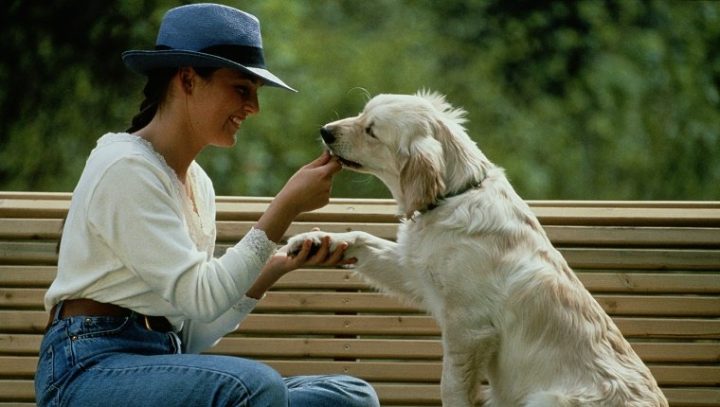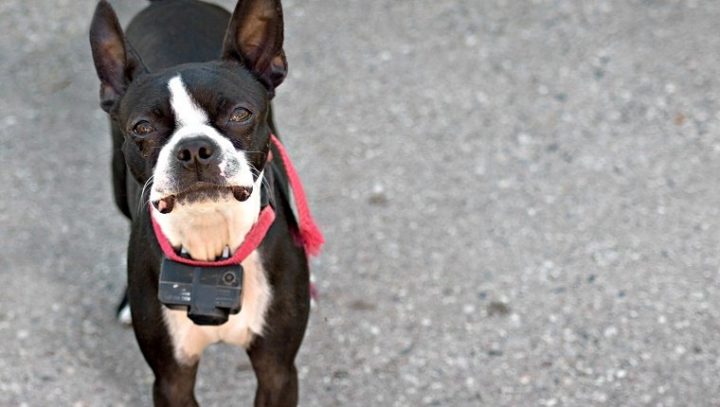There are so many popular methods of dog training that it can be difficult to figure out which method is best for your dog and which method is best for you as an owner.
If you are feeling overwhelmed, you are not alone. Within the professional dog training community, there is much disagreement even about which methods are effective and ethical, and there are several methods that overlap or are used together to get the best results.
Here are seven of the most popular dog training methods in use today and who might benefit most from using them.
1. Actively strengthen Pure positive reinforcement is the method promoted by trainers like Dawn Sylvia-Stasiewicz, who trained Obama’s dog Bo.
Pure positive reinforcement is the method promoted by trainers like Dawn Sylvia-Stasiewicz, who trained Obama’s dog Bo.
The theory behind this is fairly simple. After a reward, the dog will repeat the good behavior. Bad behavior is not rewarded or recognized. If correction is needed, it takes the form of eliminating the reward, such as taking the toy or treat away. Harsh reprimands or physical punishment are not required.
This training method begins with rewarding the desired behavior immediately within seconds of its occurrence. In this way, the dog associates the behavior with the reward.
Some trainers combine this method with answerer training (see point 3 below). This gives the dog a clear indication of exactly when the behavior will be completed. The command must also be short and clear. Sit. Stay. Come.
Positive reinforcement requires consistency. Therefore, everyone in the family needs to use the same system of commands and rewards.
Start with continuous rewards whenever your dog does the right thing. Then, gradually transition to intermittent rewards as the behavior becomes consistent. Sometimes, beginners will accidentally reward bad behavior. For example, when they start barking at a squirrel or another dog, they may let the dog out.
Only desired behaviors can be rewarded, which can include treats, toys, praise and pets. It can also be easy for your dog to overeat when he is learning, so use small treats when you get a food reward.
This method is great for learning commands, but you will need patience to correct unwanted behavior.
2. Scientific training Science-based dog training can be difficult to define because it relies on information that is constantly building and changing. It aims to understand the dog’s nature, its ability to adapt to conditions and the effectiveness of rewards and punishments.
Science-based dog training can be difficult to define because it relies on information that is constantly building and changing. It aims to understand the dog’s nature, its ability to adapt to conditions and the effectiveness of rewards and punishments.
Animal behaviorists are constantly creating new studies and experiments to shape our understanding of dog psychology. Trainers rely on these studies to work with dogs. Before correcting a behavior, it is important to know everything there is to know about the behavior.
Because science-based dog training is so extensive, it is difficult to determine the overall methodology behind it. In fact, many of the methods used in scientific dog training are used by other forms of training.
In most cases, it relies on operator conditioning, which consists mainly of positive reinforcement and, to a lesser extent, some forms of punishment.
Some scientific trainers believe it is also important to learn how to reinforce good behavior without rewards and to rely on dog psychology methods to find ways to improve the leash relationship between owners and pups.
Scientific training relies on conducting a lot of research and keeping up to date with the latest research. Therefore, it is probably best for professional trainers because the methods they use are usually effective whether you understand the science behind them or not, and many such methods have been used in other forms of training.
Again, developing new methods based on research may not be for everyone. However, it is a good idea for dog owners to stay up to date and keep an eye on new research.
3. The Clicker training

Clicker training is also based on operator conditions and relies heavily on the principles of positive reinforcement. In fact, clicker training can be grouped as a positive reinforcement approach rather than its own form of training.
It relies on the use of devices that emit a quick, sharp sound, such as a whistle, or as the name implies, a click to signal the dog when the desired behavior is completed.
The advantage of training with a question and answer machine is that it can signal the exact moment the desired behavior is completed and the exact moment the reward is being earned. The trainer can then use the quizzer to shape the new behavior and add verbal commands.
First, the dog needs to be acclimated to some conditions so that it knows that a click means a reward is coming. Then, the dog can associate the behavior with the click and the reward. Finally, verbal commands can be introduced to form new associations.
This is a great way to learn new skills and can help transform the basics into more complex tasks. Many professional trainers use this method.
While this is very useful for learning new behaviors, clicker training is not always appropriate for suppressing unwanted behaviors. When used in conjunction with other training methods, it can be very effective in ensuring that you have well-trained, well-behaved dogs.
4. e-Training Electronic training relies on the use of an electric collar that emits an electric shock or citronella spray when the dog is not performing the required task. It is primarily used for long distance training where a leash cannot be used.
Electronic training relies on the use of an electric collar that emits an electric shock or citronella spray when the dog is not performing the required task. It is primarily used for long distance training where a leash cannot be used.
For example, a shock collar can train a dog to stay in a fenceless yard. Remote collars can teach a dog to work or hunt in the field. People who use these devices claim that there is less risk of injury to the dog than with a cho collar or other mechanical device.
There are a number of problems with this method of training. One is that it relies on punishment for bad behavior rather than rewards, which means that dogs learn what they shouldn’t do, rather than what they should do.
Another problem is that it creates a lot of stress and causes permanent anxiety problems in dogs. The device is often used by inexperienced owners and is therefore overused. This can cause a lot of unnecessary physical and psychological pain to the dog.
Professional dog trainers may see desirable results from electronic training, but it is definitely not for the average owner. There are many options available to put the dog through far less stress and pain.
If electronic devices are to be used, consult a professional for proper use and consider another form of behavior modification.
5. Model competition or mirror training
The model competition approach to training relies on the fact that dogs learn through observation. By providing good models of behavior or competitors competing for resources, dogs will learn to imitate the behavior.
As a result, trainers may model others, praising them for completing command tasks or scolding them for performing undesirable behaviors. The dog as an observer learns the right way from the model.
The model can also act as a competitor, competing to complete the correct task for the desired toy or seeing it as a reward, thus encouraging the dog to take up the task and complete it faster.
Mirror training is based on the same principles, using the dog owner as a model and then providing rewards for imitating good behavior. It uses the dog’s natural instincts to socialize, rather than fight against them. Simply put, dogs learn by example.
This method of training is similar to positive reinforcement and surgical conditioning in its degree of success. However, some trainers may find it more natural and desirable.
If your dog maintains a strong bond with you and can spend a lot of time watching you and following you, then this may be a more comfortable technique than sticking to a routine.
6. Alpha dog or advantage Alpha dog or dominance training relies on the dog’s instinctive pack mentality to establish compliance and dominance.
Alpha dog or dominance training relies on the dog’s instinctive pack mentality to establish compliance and dominance.
The theory suggests that dogs view their families as their pack and follow a social hierarchy, as seen in captive wolves. When dogs see themselves as Alpha, they need to learn to respect others instead.
Some of the methods used in this technique include understanding the dog’s body language and responding accordingly, showing confidence and authority, and walking first when eating, entering or leaving a room, or walking on a leash.
If your dog wants to go outside, then they must sit on the door before opening it. If they want to eat, then they must wait calmly while the food is being prepared.
Usually, with alpha training, you do not allow your dog to use with furniture, including beds. You also do not allow your dog’s eyesight to drop. This is because these are signs that your dog has equal status in the relationship. You are in charge; you are dominant.
Cesar Millan has promoted this training method. However, sometimes he combines strengths training with other methods when appropriate.
Some modern trainers say this technique is outdated, as new research shows that dogs do not rely on pack spirit as much as previously thought, and that wolves have a different pack dynamic than when they are wild animals. Observed in captivity.
Although dominance training can curb undesired behavior, modern dog trainers often find it outdated. It may fail to address the underlying cause of the undesirable behavior and cause the dog to feel anxious or fearful.
The ongoing struggle for domination requires constant reinforcement, which can be difficult or even dangerous for children or the elderly.
7. Relationship-based training Relationship-based training combines several different training methods, but the focus is on an individualized approach for both dog and owner. The relationship between dog and human drives everything.
Relationship-based training combines several different training methods, but the focus is on an individualized approach for both dog and owner. The relationship between dog and human drives everything.
This approach strives to meet the needs of both dog and trainer, promote communication, and strengthen the bond between them. Basically, it is mutually beneficial.
Owners must know before each training session begins how to read the dog’s body language, the most motivating rewards and how to meet the dog’s basic needs. Positive reinforcement will encourage good manners.
The dog’s environment is controlled to limit the potential for undesirable behavior. The new information builds on previous successes.
For example, a dog must learn to “sit” in a quiet room before it can perform commands in a park of squirrels, children and other distractions. The level of difficulty gradually increases.
When a dog does not exhibit the desired behavior, the owner must find out why rather than punish. Does the dog distract? Hurt? Can’t hear? Or doesn’t want to perform?
This relationship-based training can produce far-reaching and meaningful connections, but it takes time and patience. It may not be enough to distinguish it from other training methods, but it seems to encompass many aspects of other successful methods.
You may find that your relationship with your dog improves regardless of which training method you use, and you can be sure that this combination will help you continue your training.
Which dog training method is best for you? Are there other methods that work? Let us know in the comments below!

